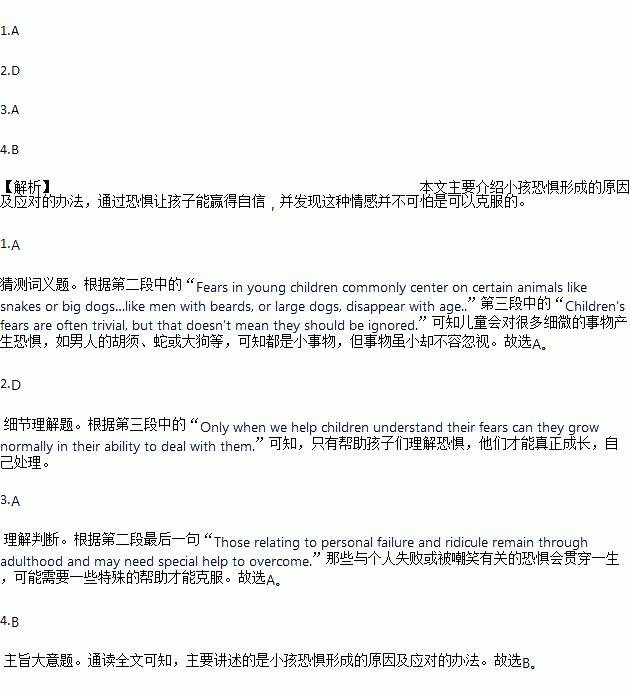题目内容
Fear is an emotion like others such as happiness, anger, hurt, sadness. We need emotions to process information we receive and decide how to respond. Being afraid of fast cars, for example, is something that might protect us from harm. Being afraid of the consequence of a choice may prevent us getting into trouble.
Fears in young children commonly center on certain animals like snakes or big dogs. Fears are caused often because of experiences or ideas expressed by others, and at times, the media. Many normal fears during the early years, like men with beards, or large dogs, disappear with age. Those relating to personal failure and ridicule (嘲笑) remain through adulthood and may need special help to overcome.
Children’s fears are often trivial, but that doesn’t mean they should be ignored. They need to be recognized and accepted as real for that child. Only when we help children understand their fears can they grow normally in their ability to deal with them.
Research shows that as a child grows up, the center of his fears changes a lot. Things like divorce, a teacher who “shouted at me”, people with guns, bullies, big boys, or “making fun of me” top the list of childhood fears.
We cannot always prevent these experiences from happening, but it’s essential that children be allowed to freely express their emotions without judgment. Sympathy and a caring listener will help ease the pain of these fears. Read books and stories to your child about children who have experienced similar fears. This helps children talk about their fears and find ways to cope. With all emotions, fears become less of a problem for children as they gain self-confidence and they find that fear is normal and can be dealt with.
1.The underlined word “trivial” in the third paragraph probably means “_______”.
A. small B. serious
C. harmful D. common
2.In dealing with children’s fears, the final goal of the parents is to _______.
A. stop unpleasant experiences happening to children
B. let children know about the nature of fear
C. create an environment where there is nothing to fear
D. develop children’s ability to treat their fear on their own
3.From the passage we can learn that ________ .
A. some childhood fears may have a lasting influence
B. children should avoid the media to reduce their fear
C. fears can be judged according to the environment
D. children with similar fears can communicate easily
4.What’s the best title for this passage?
A. How to Overcome Children’s Fears B. Children’s Fears
C. The kind of Children’s Fears D. The Bad Effects of Fears
 阅读快车系列答案
阅读快车系列答案On the day of Chongyang Festival,one traditional activity is to climb mountains.However,mountains are not everywhere for people to climb.Therefore,for those people who live in flat regions far from any mountain,the problem is solved by going for a picnic and eating cakes.The Chinese word for cake is Gao,a homonym of the Chinese word for high.Mountains are high,so eating cakes can,by a stretch of the imagination,take the place of going for a climb.
The tradition of eating cakes in September is originated from the ancient times.Though the name of “Gao” started from the Six Dynasties,the cakes had already existed in Han Dynasty,which was called “Er”.in Chinese at that time.It is made of rice flour,which is classified into two types:paddy(水稻) rice flour and millet(粟米) rice flour.They are mixed together,which is named “Er”.In September,the millet is ripe.It is regarded as the food just in season,which is offered to ancestors as sacrifices.Chongyang Cake comes from the food just in season in September.That is why Chongyang Cake is recommended for offering sacrifices to ancestors on the day of Chongyang Festival.
In the Six Dynasties,cakes became the food for the season as the tradition Chongyang Festival is formed with the promotion of mountain?climbing activity.As the cakes appeared in different forms,Chongyang Cake was also called Hua (Colorful) Cake in the Ming & Qing Dynasties and became the food for the season in urban and rural areas.Hua Cake is divided into Unpolished Hua Cake,Refined Hua Cake and Gold Coin Hua Cake.Unpolished Hua Cake is marked with caraway (香菜) leaves,sandwiched with date,peach kernel (果仁) and other unpolished dry fruits.Refined Hua Cake is made in either two or three layers,with each sandwiched with refined glazed fruits,such as preserved apple,peach and apricot.
Title: 1. Cake | |
2. | ·taking the place of going for a climb ·being offered as 3. |
Eating time | In 4. |
Related activities | (1)in mountain areas:climbing mountains (2)in 5. areas: ·going for a picnic ·eating 6. |
7. | (1)Han Dynasty:called 8. ·paddy rice flour ·millet rice flour (2) 9. Dynasties:called “Gao” ·Unpolished Hua Cake ·10. Hua Cake ·Gold Coin Hua Cake |

